If you’re looking for something to brighten up your home during the dark winter days, an amaryllis (genus Hippeastrum) might be a good choice. These unassuming bulbs produce amazing flowers in a wide range of colors, the result of a long history of selective breeding.
Keep reading for everything you need to know about growing an amaryllis indoors and how to make sure yours blooms beautifully year after year.
| Common name(s) | Amaryllis, Barbados lily, lily of the palace |
| Scientific name | Hippeastrum sp. |
| Family | Amaryllidaceae |
| Height and spread | Up to 5 inches bulb diameter, 36 inches in height |
| Light | Plenty of sun |
| Soil type | Well-draining but rich |
| Water | Dependent on the season |
Disclosure: If you shop from my article or make a purchase through one of my links, I may receive commissions on some of the products I recommend.
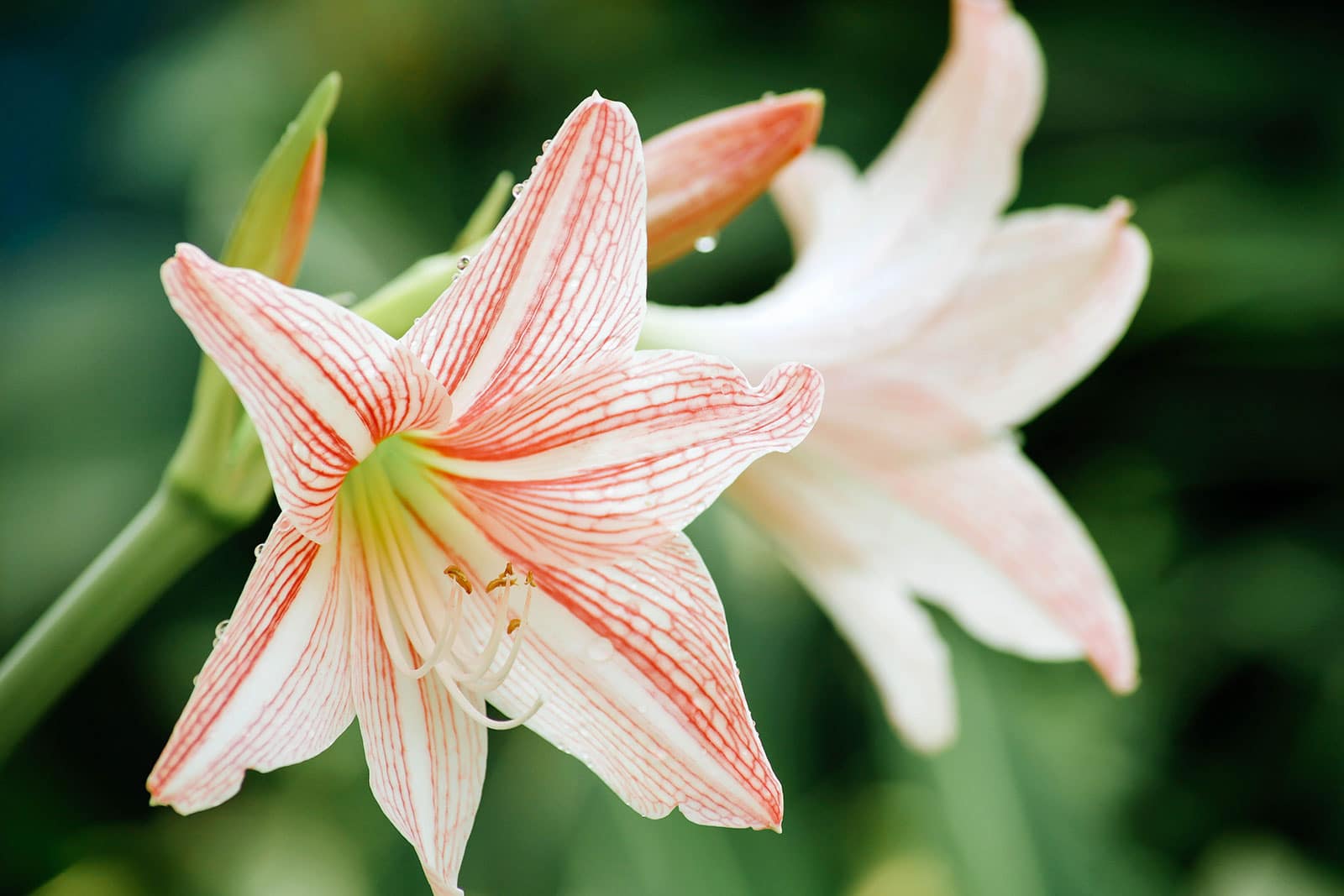
About amaryllis
Taxonomy
Before we discuss amaryllis care, a quick word on taxonomy so we’re all on the same page about which plant we’re talking about.
Like many other plants, amaryllis have been the subject of much taxonomical debate. They were at first placed in the African genus Amaryllis, but this was later changed to Hippeastrum when it became clear this is a different species from South America.
Sounds simple, but it involved over 50 years of debate, not to mention that until 1970 the name Leopoldia was also accepted.
Despite the move from the genus Amaryllis (African spring bloomer) to the genus Hippeastrum (South American winter bloomer), the name stuck. We still refer to the winter bloomer as amaryllis, though without the capitalization that we’d use for a genus name.
Did you know?
Although some of its common names refer to amaryllis as a lily, they’re not actually related to true lilies. Their flowers just look alike!
Natural habitat
Unlike the “true” Amaryllis, Hippeastrum is naturally found in South America. There are actually more than 90 different species out there with a very wide range (and new ones are described on the regular!), although the largest concentration is found in Brazil.
Due to this wide spread, it isn’t possible to pinpoint a single habitat: some amaryllis species grow in the tropics, while others are found in temperate climates. Some like the scorching sun, others prefer more shaded spots. Water and soil needs vary as well.
Description
Despite there being so many different types of amaryllis, one thing they have in common is their looks. These plants grow from bulbs with a papery exterior and smooth interior.
During the summer months, when it’s not blooming, an amaryllis will usually sport long green leaves. Once winter rolls around and the blooms appear, these leaves tend to die off. This leaves only one or multiple thick, straight green stems, with any number of large flowers in shades of white, orange, pink, and red.
Although it’s not uncommon for an amaryllis to be reduced to just its bulb for some of the year, this is really a very spectacular plant when it blooms. It’s not difficult to imagine why it became so popular!
Cultural significance
Amaryllis has an almost 200-year history, starting from when it was likely first described in the mid-18th century.
The first cross had been produced in England by the early 19th century and the hybridization and selective cultivation of the different species hasn’t stopped since. Nowadays, there are amaryllis in many colors, with different flower shapes, sizes, and numbers.
Related: Get the lowdown on plant taxonomy: cultivars, varieties, hybrids and more
The commercial interest in these plants probably has something to do with their blooming time, right in the middle of winter in the Northern Hemisphere. What could be more attractive than a few huge flowers to brighten your home during these gloomy months?
Like other winter bloomers such as Christmas cacti and Cyclamen, amaryllis is now a classic Christmas flower. The bulbs are widely sold as gifts or decorations in ornamental pots and vases.
Amaryllis have become synonymous with the holiday season because when they’re grown as houseplants, they usually bloom in December. (This is in stark contrast to their natural blooming period in summer when they’re grown outdoors in the ground.)
The showy trumpet flowers come in a range of colors (including bicolor and picotee varieties), but red amaryllis tends to be a Christmas favorite.
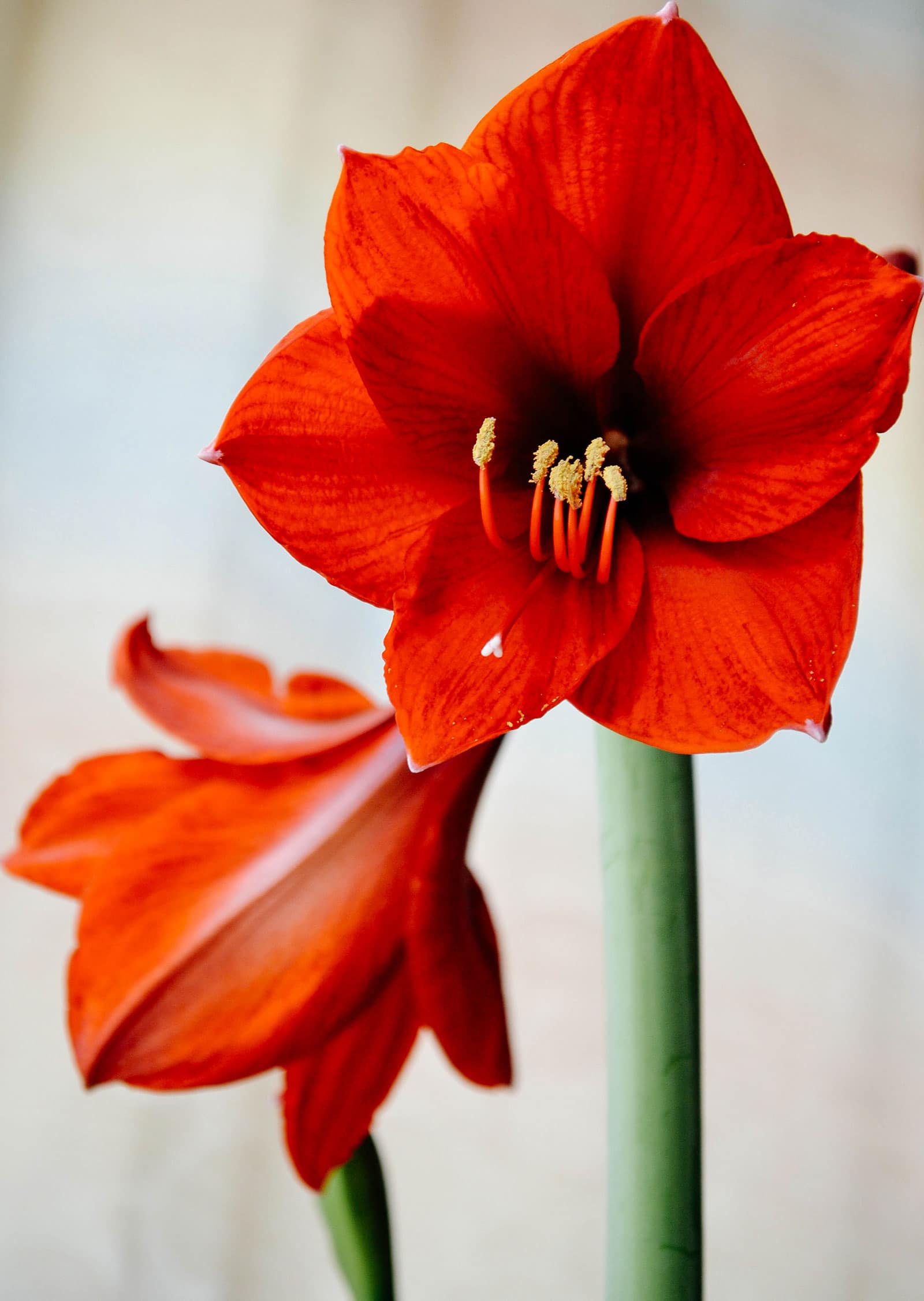
Amaryllis varieties
Due to the extensive hybridization and selective breeding of Hippeastrum, there are literally hundreds of different cultivars out there, not to mention hybrids between different species. More than I could ever describe here!
If you’d like to explore some of the endless amaryllis varieties, the Pacific Bulb Society has a Hippeastrum hybrid page.
Here are a few of my favorites:
- Amaryllis ‘Red Lion’: Perhaps the most famous amaryllis, this classic bright red flower is also one of the most foolproof varieties to grow. Each stem produces three or four showstopping blooms up to 8 inches across.
- Amaryllis ‘Apple Blossom’: As one of the most popular pink amaryllis, this old-time favorite is a real knockout and features white blooms brushed with rosy pink. The large flowers can span up to 7 inches across.
- Amaryllis ‘Picotee’: This distinctive variety boasts massive, snowy white blooms spanning 8 inches across, with a fine, crisp red edge on the petals. Each bulb produces two stout stems with four to five flowers each.
- Amaryllis ‘Giant Amadeus’: This double-blooming giant amaryllis features huge, dazzling white flowers with rosy red veins. The flowers are larger than typical amaryllis flowers, reaching up to 10 inches across on sturdy stems.
- Amaryllis ‘Pink Nymph’: This head-turning variety is a glamorous choice for winter color, with its rich, rosy pink double flowers that open up to 10 inches across. Each bulb produces four extra-large flowers per stem.
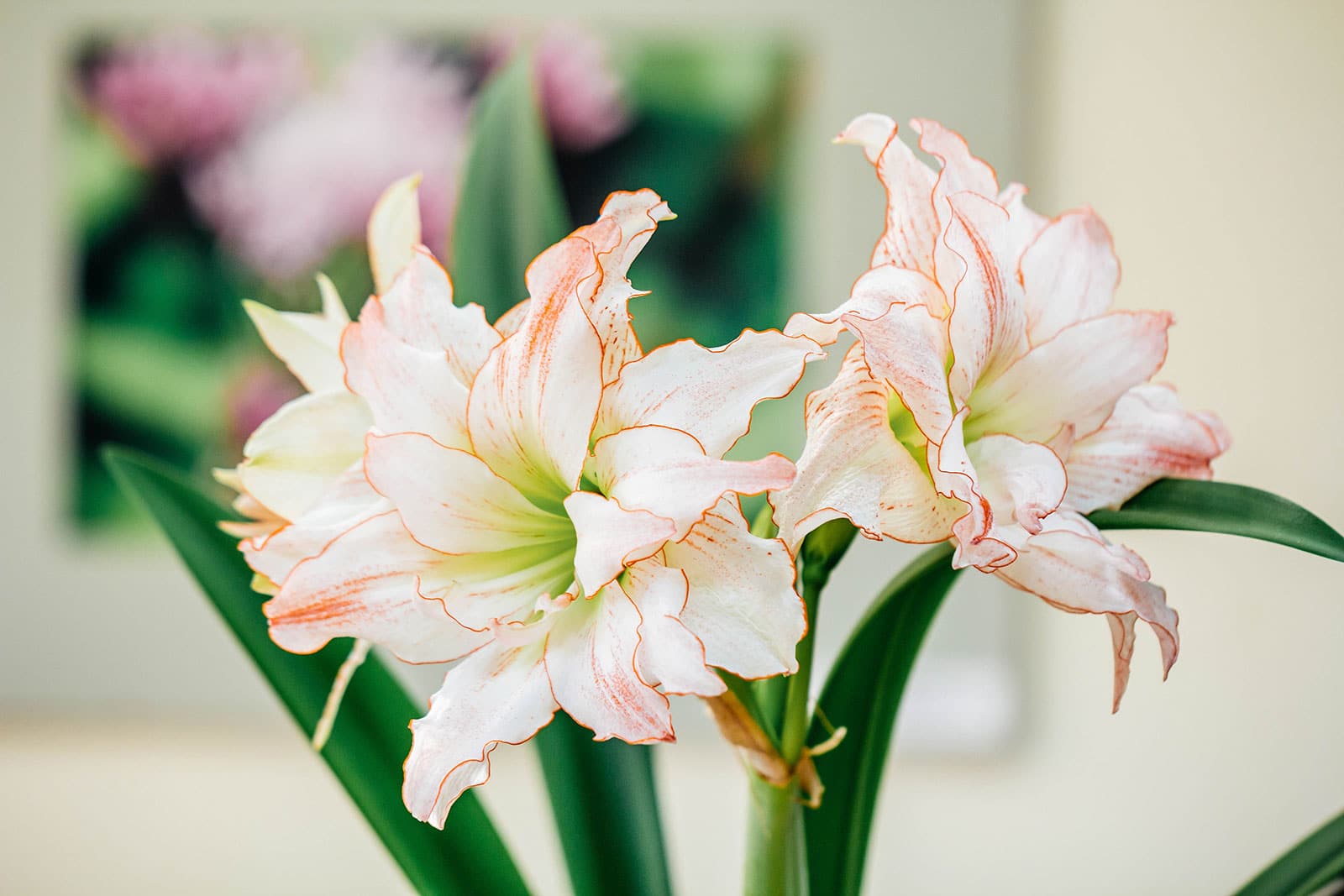
When purchasing amaryllis bulbs for yourself or as gifts, you can go with either an early-blooming South African amaryllis to deliver gorgeous color during the holidays, or a later-blooming Dutch amaryllis to brighten up the dark days of January once all the lights and decorations are put away.
Amaryllis bulbs are typically sold as dormant bareroot bulbs, or pre-potted in soil and ready for display. You might even come across waxed bulbs, which are extremely popular as Christmas gifts in the US and Europe.
Where to buy
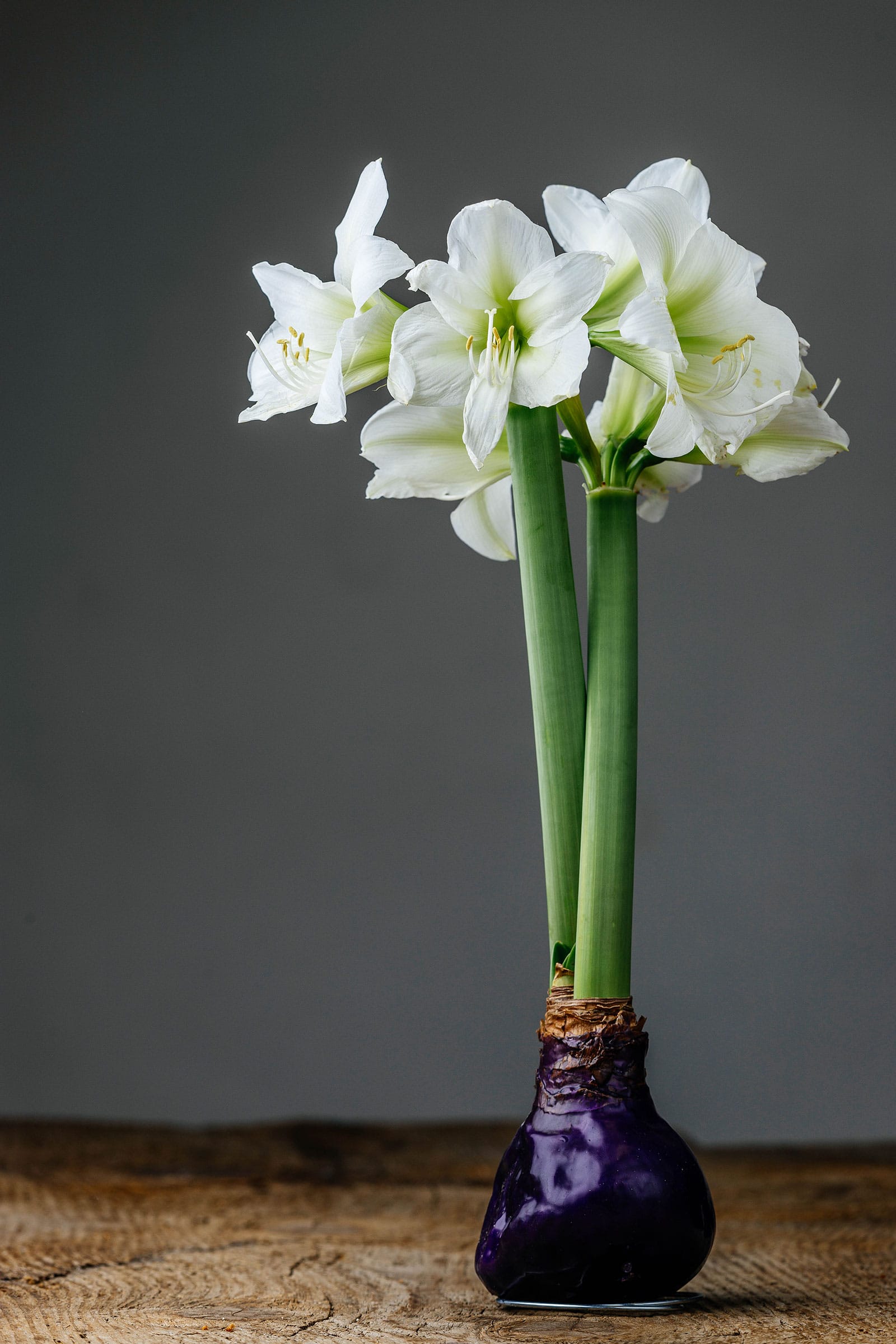
What are waxed amaryllis bulbs?
Waxed amaryllis bulbs are as low-maintenance as they get. An innovation from Holland, the special wax coating renders them incredibly easy to grow since they require no water and no soil. All the nutrients they need to begin blooming are packed into that big round bulb, making them ready to produce flowers in as little as three to six weeks after reaching the consumer.
The wax itself is a decorative element, available in many festive colors and designs and incorporating a hidden metal stand to keep the plant upright during blooming.
This same metal stand also makes it possible to display your waxed amaryllis bulb upside-down from a special brass hanger like this one. When grouped together, hanging amaryllis make for a stunning focal point in a room.
Despite what sounds like a great thing, a waxed amaryllis bulb is a one-time wonder. Because the wax prevents the bulb from growing new roots, the amaryllis won’t live beyond the bloom period. Once the last flowers fade, the bulb has to be discarded.
This makes a waxed bulb rather expensive compared to an unwaxed bulb, so think of it more like a fresh floral centerpiece that you can enjoy for a few weeks (and not a houseplant that blooms year after year).
Flowers from waxed amaryllis bulbs also tend to be shorter and stockier than their unaltered counterparts. So if you want the traditional tall amaryllis flowers that last up to six weeks, make sure you buy an unwaxed bulb that grows in soil.
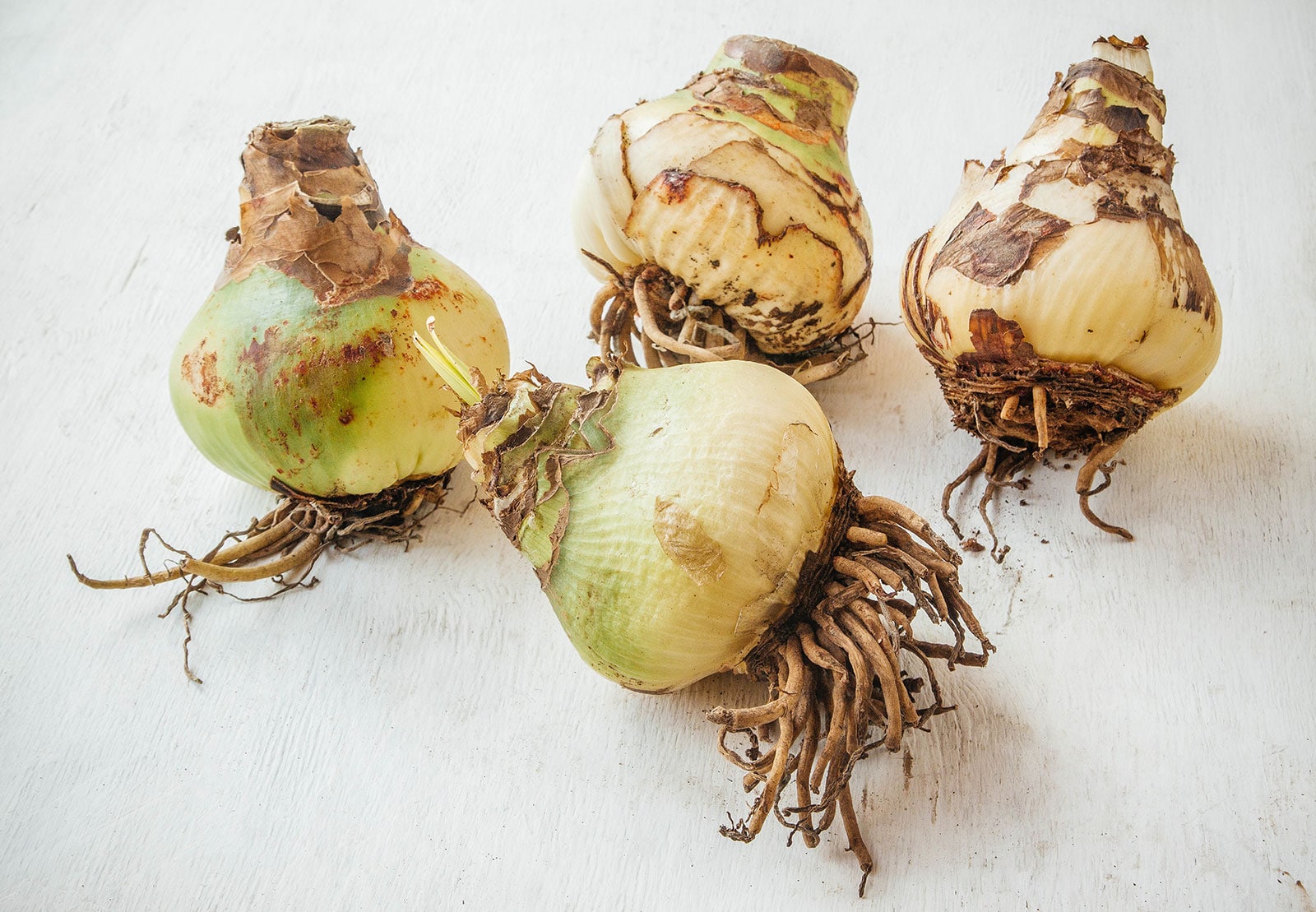
Caring for amaryllis indoors
The most important thing to keep in mind if you want your amaryllis to thrive long-term is that their needs vary according to the season.
Light and temperature
Your amaryllis will appreciate bright light throughout the year except if you’re forcing blooming (which I’ll talk more about later). They can handle a bit of direct sun, although light shade isn’t a problem either, especially outdoors where the light is stronger.
If your amaryllis is flowering, it can be helpful to protect it from the strongest rays to avoid damaging the blooms.
The ideal temperature for an amaryllis varies with the seasons as well, though it’s important to remember that these plants aren’t frost-hardy. They like to be outside for part of the year, but should be brought back in for blooming once outdoor temperatures drop into the 50s (Fahrenheit).
Water and humidity
For most of the year, your amaryllis will appreciate regular waterings. Let the top few inches of the soil dry out before watering again to prevent it from staying too soggy, but don’t wait until the soil is bone dry. Let excess water drain from the pot; bulbs are very sensitive to rot!
When it comes to humidity, amaryllis aren’t very demanding. Although they won’t appreciate very low humidity, the normal air moisture levels in a home should be fine for them.
Soil and planting
Amaryllis bulbs aren’t difficult when it comes to containers and soil either. Select a planter that’s only a bit larger than the bulb and has a drainage hole in the bottom. Wet feet can cause bulb rot!
The soil mixture should be well-draining too, but also contain plenty of rich, organic material. A peat-based potting soil works well, especially with a handful of perlite to make it less compact. If you’ve got something like compost or worm castings on hand, your amaryllis will definitely appreciate some of that.
When potting your bulb, don’t bury it. Up to half can remain exposed; just make sure the roots are covered.
Recommended
Growing supplies
Fertilizing
As you’ve probably gathered from the previous section, amaryllis loves a bit of fertilizer. You can include some manure, worm castings, or compost in your potting mix, but the use of a diluted liquid houseplant fertilizer will also be appreciated. As long as you see growth on your amaryllis bulb (leaves or stems), include some plant food with every other watering.
Stop fertilizing when the bulb isn’t producing any leaves or other growth. It doesn’t need any additional nutrients during these periods.
Recommended
Fertilizers
Pruning
Most sources recommend removing the flower stalk after an amaryllis has finished flowering, but I don’t really see why this would be necessary. As long as it’s green, it photosynthesizes, providing energy for the bulb. Once it does go yellow, you can remove the stem with a sharp knife.
Do make sure to remove the flowers themselves after they’re spent. Unless you want to grow amaryllis from seed, the development of the pods only drains energy.
You want the bulb to be able to photosynthesize as much as possible after the blooming period to make sure it has the strength to rebloom next year! (Or even bloom twice in the same year.) This is also why you should leave any foliage your amaryllis produces alone to let it work its magic.
Dividing or repotting
Amaryllis bulbs are not very quick growers, though they can eventually outgrow their containers. You can repot the plant following the steps in the section above (on soil and planting), preferably right after a dormancy period when new growth is just starting to pop up.
You can also divide your amaryllis using the instructions on propagation below. This works well if you feel the bulbs are really starting to look a bit crowded, or if you’d like to have a few extra bulbs to give away.
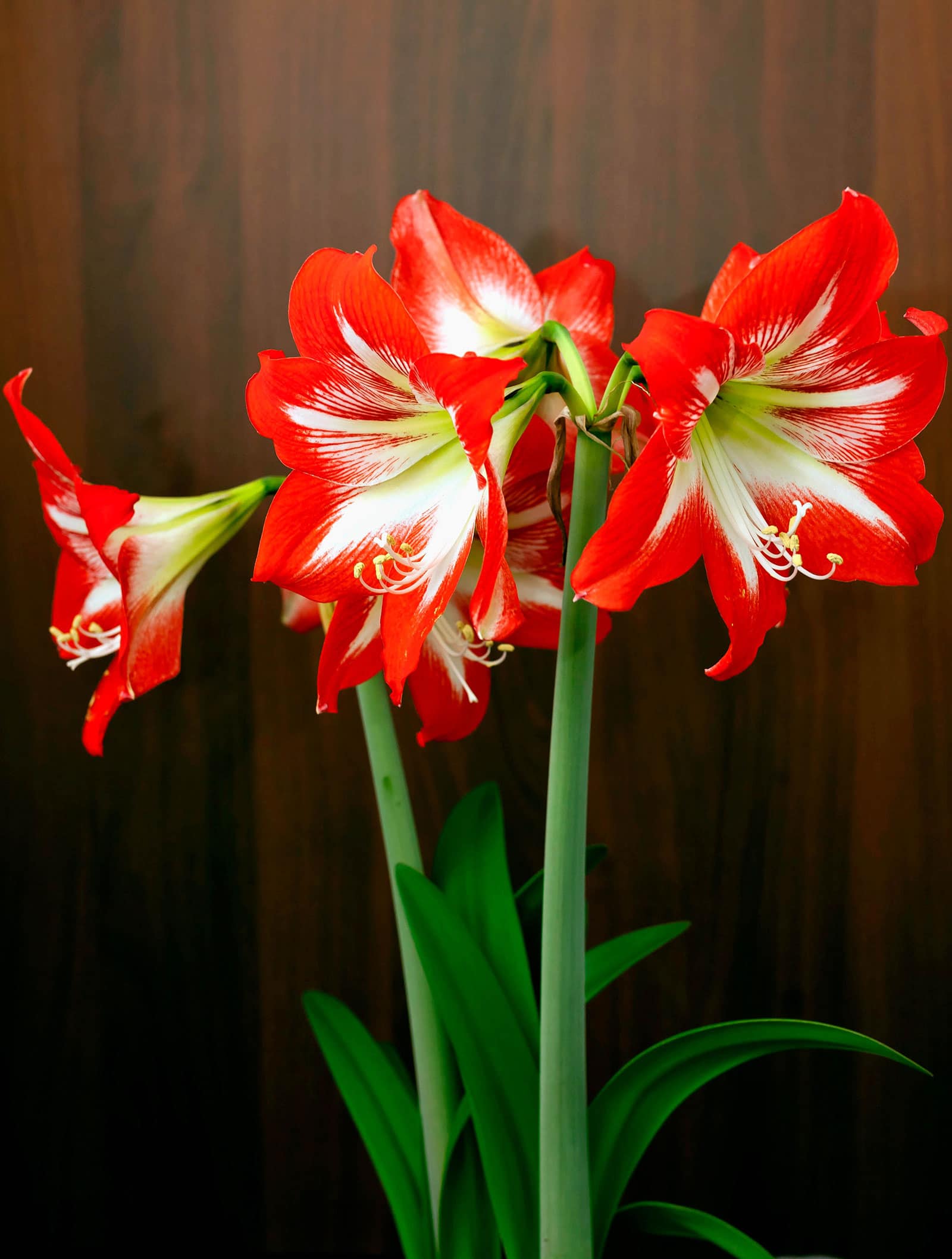
Propagating amaryllis
The easiest way to propagate amaryllis is through bulb division. The plant does most of the work for you; mature and healthy amaryllis bulbs produce offsets in the form of new, smaller bulbs. You can leave these if you like the look of a big cluster of flowers, but you can also separate them.
Like repotting, propagating amaryllis is best done right after a dormancy period, when the plant is just starting to push out new growth. The easiest way to go about it is to take the whole thing out of its planter, allowing you to see all the offsets and selecting the best ones to separate.
Don’t remove bulblets that are still very small! They should be at least around one-third to half of the size of the original “mother” bulb.
The actual process of dividing the bulbs is easy as pie. A good tug or careful twist should usually be enough to loosen the bulblet, although you can also use a tool to pry it off the mother bulb if it’s firmly attached.
Just be careful with the roots. Pot up your brand new amaryllis bulb like you would normally.
If your amaryllis bulb doesn’t have any offsets but appears healthy, you can still propagate it using a method called bulb sectioning.
Bulb sectioning involves digging up the bulb, cleaning it, and cutting it straight from the top to the bottom into multiple sections. (According to research, you can divide it into up to 96 sections, but let’s start with 2 or 4!)
Apply some fungicide and plant each section. New bulbs should start growing, although it can be a few seasons before you spot the first flowers.
Lastly, you can also grow amaryllis plants from seed. This is mainly done by horticulture enthusiasts who enjoy crossing different hybrids and cultivars to create new ones, because the process is a bit too slow for the average hobbyist.
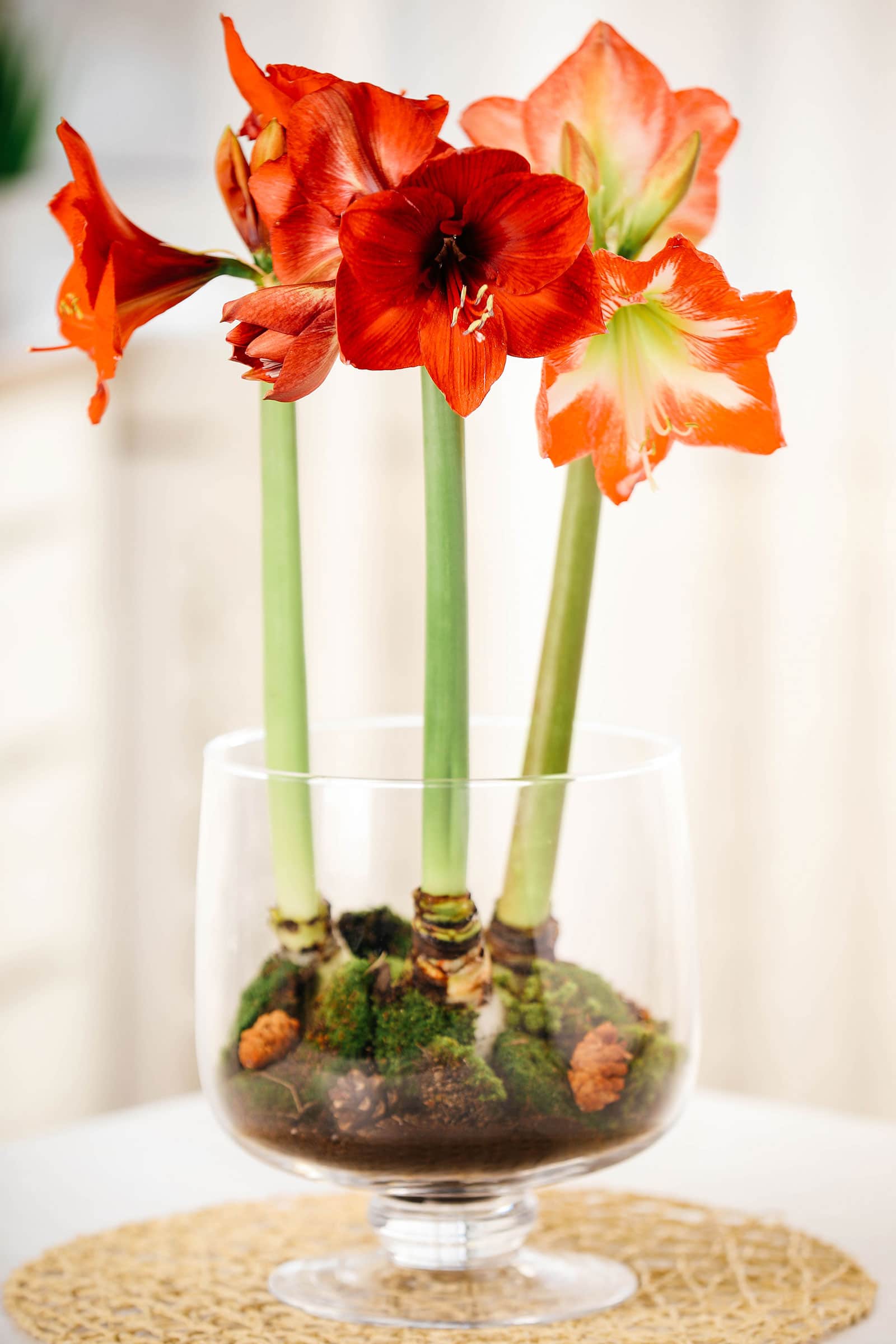
How can I make my amaryllis bloom?
The question you’ve probably been asking yourself throughout this care guide! Usually, you don’t actually have to do much aside from following the yearly cycle:
- Once the flowers are spent, remove them. Remove the stalk once it goes yellow. Fertilize regularly and make sure your amaryllis gets lots of sun.
- When the risk of frost clears in spring, move your potted amaryllis outdoors. Continue watering and fertilizing regularly, still providing plenty of light.
- Once temperatures start to drop, bring the plant back in. The sudden move from the cooler outdoors to your warm home should do the trick.
- It’s recommended to place the plant in a slightly cooler spot in your home once it starts blooming. This way the flowers don’t fade as quickly.
You don’t need to take any special steps to get your amaryllis to bloom, like letting the bulb go dormant for part of the year. It can continue growing leaves just fine. This being said, you can actually force a dormant period, which is a trick used to ensure an amaryllis blooms at a set time.
Here’s how to force an amaryllis to bloom:
- Rather than placing the bulb in a window after you bring it indoors, pop it in a box in a place like your basement or garage. It should be cool and dry, without any light reaching the bulb.
- The foliage will die off and if all goes well, the bulb will enter a dormant state where it neither grows nor dies.
- You can leave the bulb for two to three months, unless it sprouts any new growth before the end of the designated dormancy period (in which case you should move it to its normal indoor spot).
- At the moment of your choosing, you can take the amaryllis bulb out of the dark and place it on a sunny windowsill. Start watering and fertilizing to wake it up.
- If you’ve done everything right throughout the past year, a flower stalk should begin to sprout soon. Your amaryllis might start blooming in as little as a month.
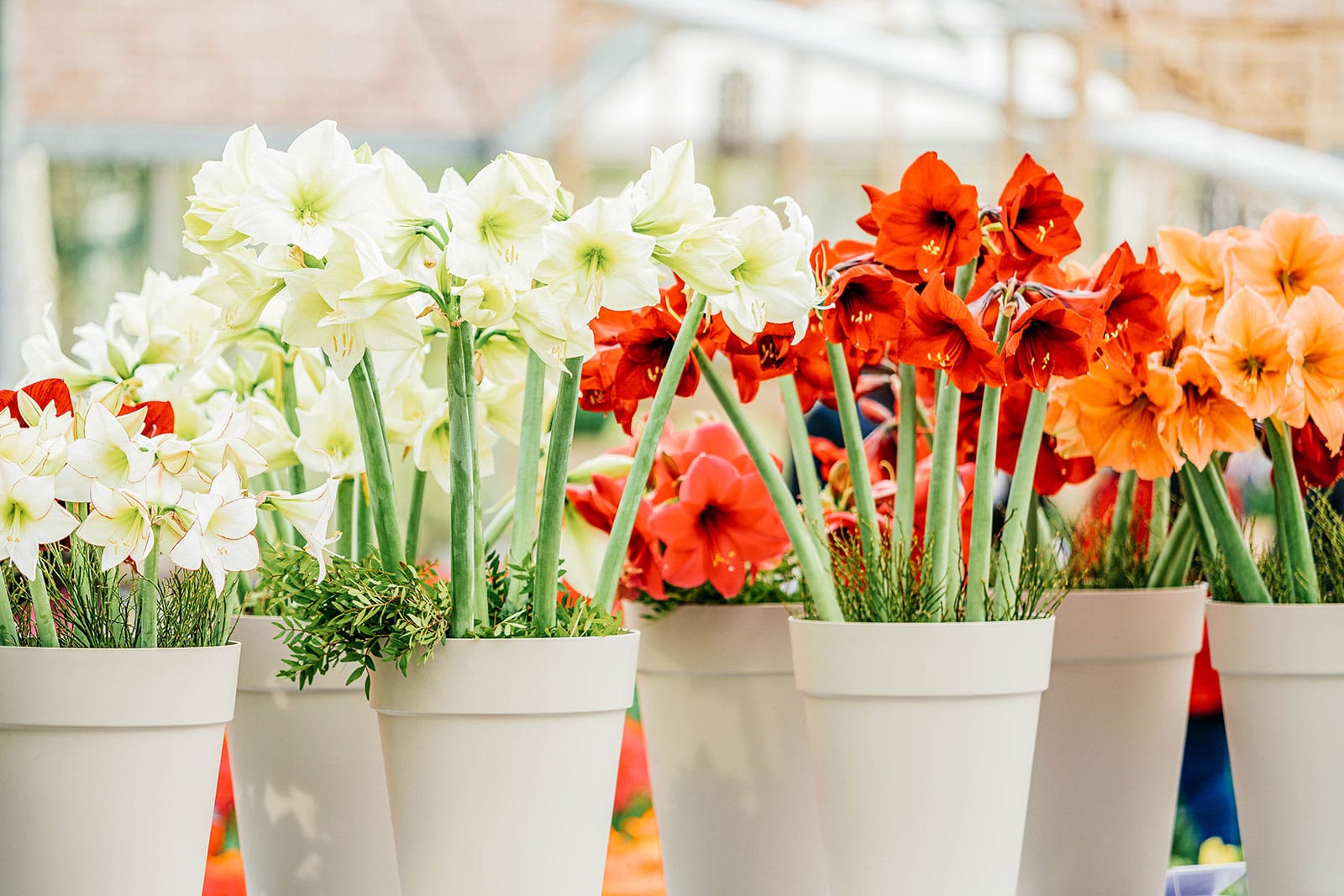
Common questions about amaryllis
How long does it take for Christmas amaryllis to bloom?
Once planted, an amaryllis bulb takes six to eight weeks to begin blooming. That means if you want a lovely, fully-bloomed amaryllis for Christmas, you should plant and water it in early November, to be on the safe side. (Keep in mind this timeline applies to dormant bulbs without stems.)
How many years will an amaryllis bulb bloom?
With proper care, an amaryllis bulb will grow, bloom, and rebloom for decades. The average lifespan of a bulb is about 25 years, though it’s not unheard of for an heirloom amaryllis to be passed down through families for 50 years or more.
Is amaryllis the same as belladonna lily?
Amaryllis (the name usually given to Hippeastrum bulbs) is not the same as belladonna lily. And here’s where it gets confusing: Although we know the winter blooming flower bulb as amaryllis (note that its common name isn’t capitalized), it isn’t a true Amaryllis—that is, it doesn’t belong to the genus Amaryllis.
The genus Amaryllis only has two species and the better known of the two is Amaryllis belladonna, a flowering bulb that you might be more familiar with as belladonna lily, naked lady, Jersey lily, or March lily (which are all different names for the same plant).
Is amaryllis toxic to cats and dogs?
According to the ASPCA, yes. Unfortunately, the bulb especially contains poisonous alkaloids that can cause severe stomach upset in cats and dogs.
Sources:
- Büneker, H. M., Soares, K. P., de Assis, L. C., & Witeck-Neto, L. (2018). Taxonomic novelties in Southern Brazilian Amaryllidaceae–III: Hippeastrum multiflorum, a new species from Rio Grande do Sul. Balduinia, (64), 34-41.
- Datta, S. K. (2020). Amaryllis/Hippeastrum. Floriculture and Ornamental Plants, 1-27.
- Kharrazi, M., Tehranifar, A., Nemati, H., & Bagheri, A. (2017). Vegetative propagation of Amaryllis (Hippeastrum× johnsonii) by different cutting methods.
- Sealy, J. R. (1939). Amaryllis and Hippeastrum. Bulletin of Miscellaneous Information (Royal Botanic Gardens, Kew), 1939(2), 49-68.


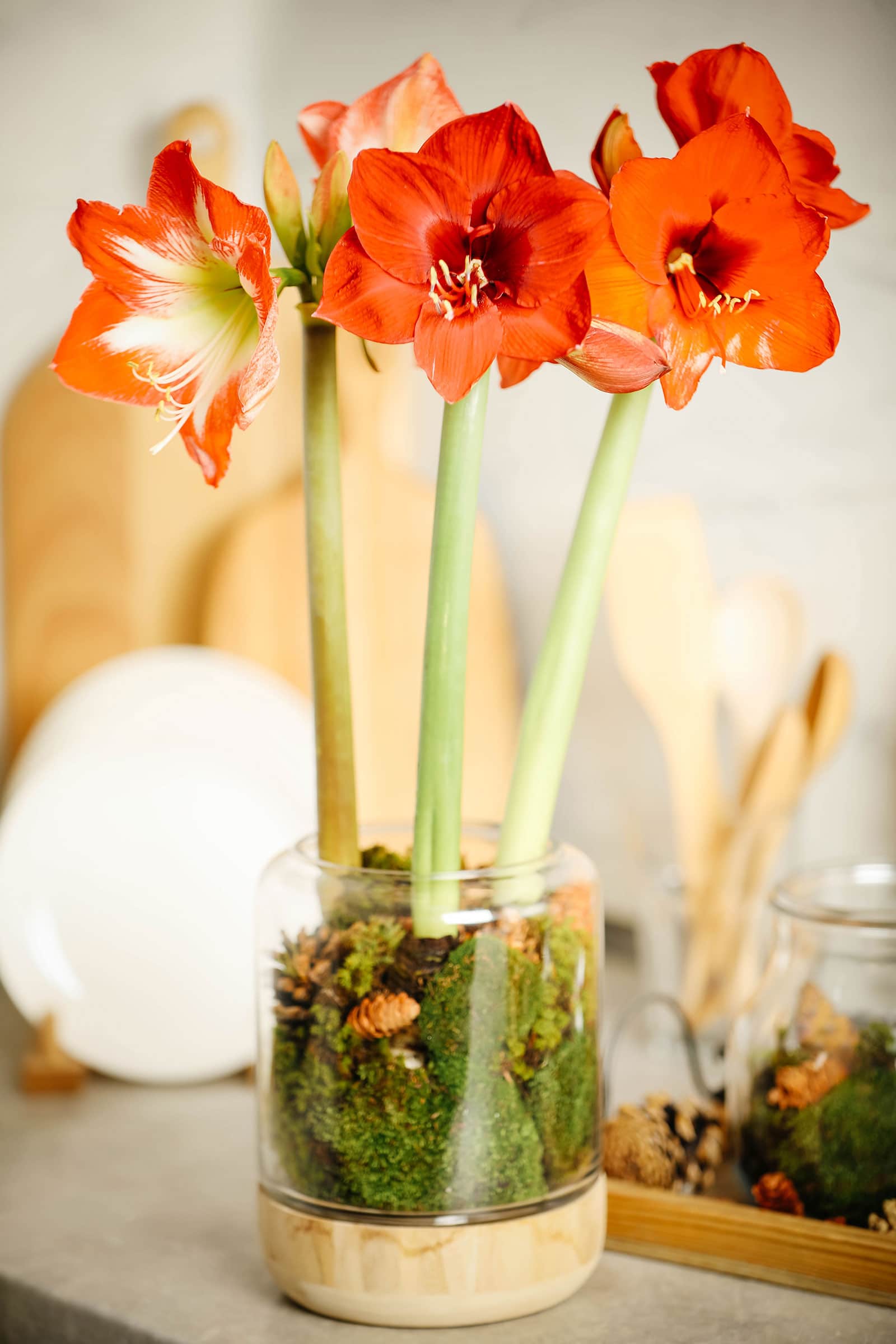













I enjoyed the article, but would have loved some tips for growing them outdoors in front of my home, because something is eating one of my bulbs, and I was looking for natural home remedies to help with that. Also, I did not see a picture of the type of amaryllis that I have. It’s a very dark red, crimson if you will. I’ll share pictures once they’ve bloomed, if you’re interested.
Have an amaryllis that grows about 4 feet tall. It bloomed the first time I got it but hasn’t since. I have it outside now on the porch using yarn to give it some support. Also do you also have information or suggestions about African violets ? Thank you for your time.
My amaryllis bloomed in January. I eventually cut the spent blooms off and let the leaves continue to grow. It is May and the leaves have turned brown so I cut them off. Now what do I do? It seems to early for them to be dormant. They are in a sunny location.